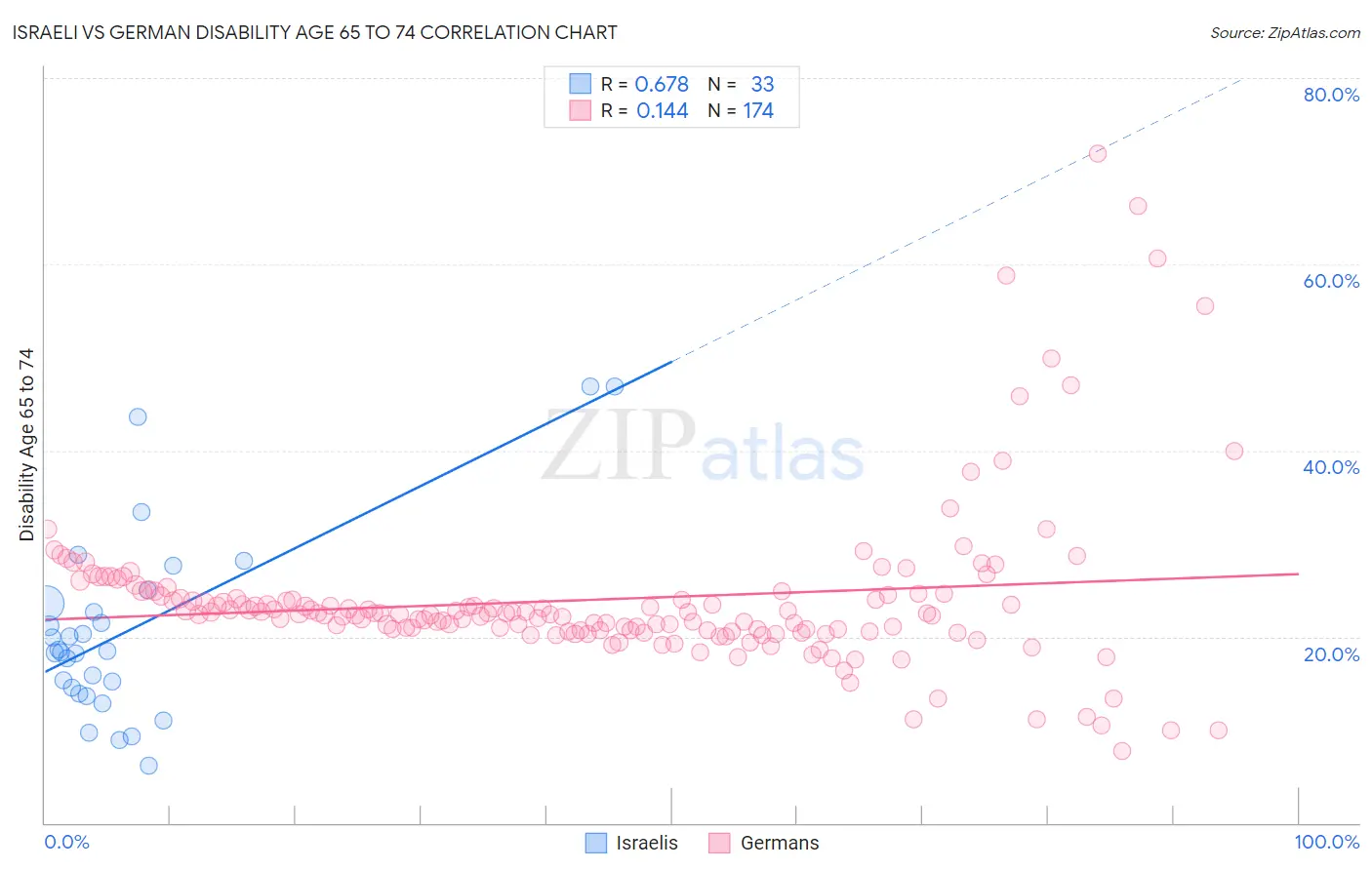Israeli vs German Disability Age 65 to 74
COMPARE
Israeli
German
Disability Age 65 to 74
Disability Age 65 to 74 Comparison
Israelis
Germans
21.2%
DISABILITY AGE 65 TO 74
99.8/ 100
METRIC RATING
37th/ 347
METRIC RANK
23.3%
DISABILITY AGE 65 TO 74
50.5/ 100
METRIC RATING
172nd/ 347
METRIC RANK
Israeli vs German Disability Age 65 to 74 Correlation Chart
The statistical analysis conducted on geographies consisting of 210,778,329 people shows a significant positive correlation between the proportion of Israelis and percentage of population with a disability between the ages 65 and 75 in the United States with a correlation coefficient (R) of 0.678 and weighted average of 21.2%. Similarly, the statistical analysis conducted on geographies consisting of 577,988,449 people shows a poor positive correlation between the proportion of Germans and percentage of population with a disability between the ages 65 and 75 in the United States with a correlation coefficient (R) of 0.144 and weighted average of 23.3%, a difference of 10.3%.

Disability Age 65 to 74 Correlation Summary
| Measurement | Israeli | German |
| Minimum | 6.1% | 7.7% |
| Maximum | 46.9% | 71.9% |
| Range | 40.8% | 64.2% |
| Mean | 20.8% | 24.0% |
| Median | 18.5% | 22.5% |
| Interquartile 25% (IQ1) | 14.2% | 20.7% |
| Interquartile 75% (IQ3) | 24.3% | 24.5% |
| Interquartile Range (IQR) | 10.1% | 3.8% |
| Standard Deviation (Sample) | 10.1% | 8.7% |
| Standard Deviation (Population) | 10.0% | 8.7% |
Similar Demographics by Disability Age 65 to 74
Demographics Similar to Israelis by Disability Age 65 to 74
In terms of disability age 65 to 74, the demographic groups most similar to Israelis are Russian (21.2%, a difference of 0.0%), Immigrants from Switzerland (21.1%, a difference of 0.11%), Argentinean (21.2%, a difference of 0.19%), Bulgarian (21.1%, a difference of 0.30%), and Latvian (21.2%, a difference of 0.35%).
| Demographics | Rating | Rank | Disability Age 65 to 74 |
| Immigrants | Greece | 99.9 /100 | #30 | Exceptional 21.0% |
| Immigrants | Northern Europe | 99.9 /100 | #31 | Exceptional 21.0% |
| Turks | 99.9 /100 | #32 | Exceptional 21.0% |
| Immigrants | Argentina | 99.9 /100 | #33 | Exceptional 21.1% |
| Immigrants | Sri Lanka | 99.9 /100 | #34 | Exceptional 21.1% |
| Bulgarians | 99.9 /100 | #35 | Exceptional 21.1% |
| Immigrants | Switzerland | 99.8 /100 | #36 | Exceptional 21.1% |
| Israelis | 99.8 /100 | #37 | Exceptional 21.2% |
| Russians | 99.8 /100 | #38 | Exceptional 21.2% |
| Argentineans | 99.8 /100 | #39 | Exceptional 21.2% |
| Latvians | 99.8 /100 | #40 | Exceptional 21.2% |
| Immigrants | Austria | 99.8 /100 | #41 | Exceptional 21.2% |
| Macedonians | 99.7 /100 | #42 | Exceptional 21.3% |
| Immigrants | Croatia | 99.7 /100 | #43 | Exceptional 21.3% |
| Estonians | 99.7 /100 | #44 | Exceptional 21.4% |
Demographics Similar to Germans by Disability Age 65 to 74
In terms of disability age 65 to 74, the demographic groups most similar to Germans are Yugoslavian (23.3%, a difference of 0.020%), Immigrants from South Eastern Asia (23.3%, a difference of 0.030%), Dutch (23.3%, a difference of 0.070%), Cuban (23.3%, a difference of 0.080%), and Immigrants from Eritrea (23.4%, a difference of 0.17%).
| Demographics | Rating | Rank | Disability Age 65 to 74 |
| Vietnamese | 60.8 /100 | #165 | Good 23.2% |
| Immigrants | Afghanistan | 60.5 /100 | #166 | Good 23.2% |
| Immigrants | Bosnia and Herzegovina | 57.6 /100 | #167 | Average 23.2% |
| Pakistanis | 57.0 /100 | #168 | Average 23.2% |
| Icelanders | 54.3 /100 | #169 | Average 23.3% |
| Moroccans | 54.2 /100 | #170 | Average 23.3% |
| Cubans | 51.9 /100 | #171 | Average 23.3% |
| Germans | 50.5 /100 | #172 | Average 23.3% |
| Yugoslavians | 50.2 /100 | #173 | Average 23.3% |
| Immigrants | South Eastern Asia | 50.0 /100 | #174 | Average 23.3% |
| Dutch | 49.4 /100 | #175 | Average 23.3% |
| Immigrants | Eritrea | 47.5 /100 | #176 | Average 23.4% |
| Immigrants | Haiti | 47.5 /100 | #177 | Average 23.4% |
| Guyanese | 45.8 /100 | #178 | Average 23.4% |
| Immigrants | Sierra Leone | 45.8 /100 | #179 | Average 23.4% |